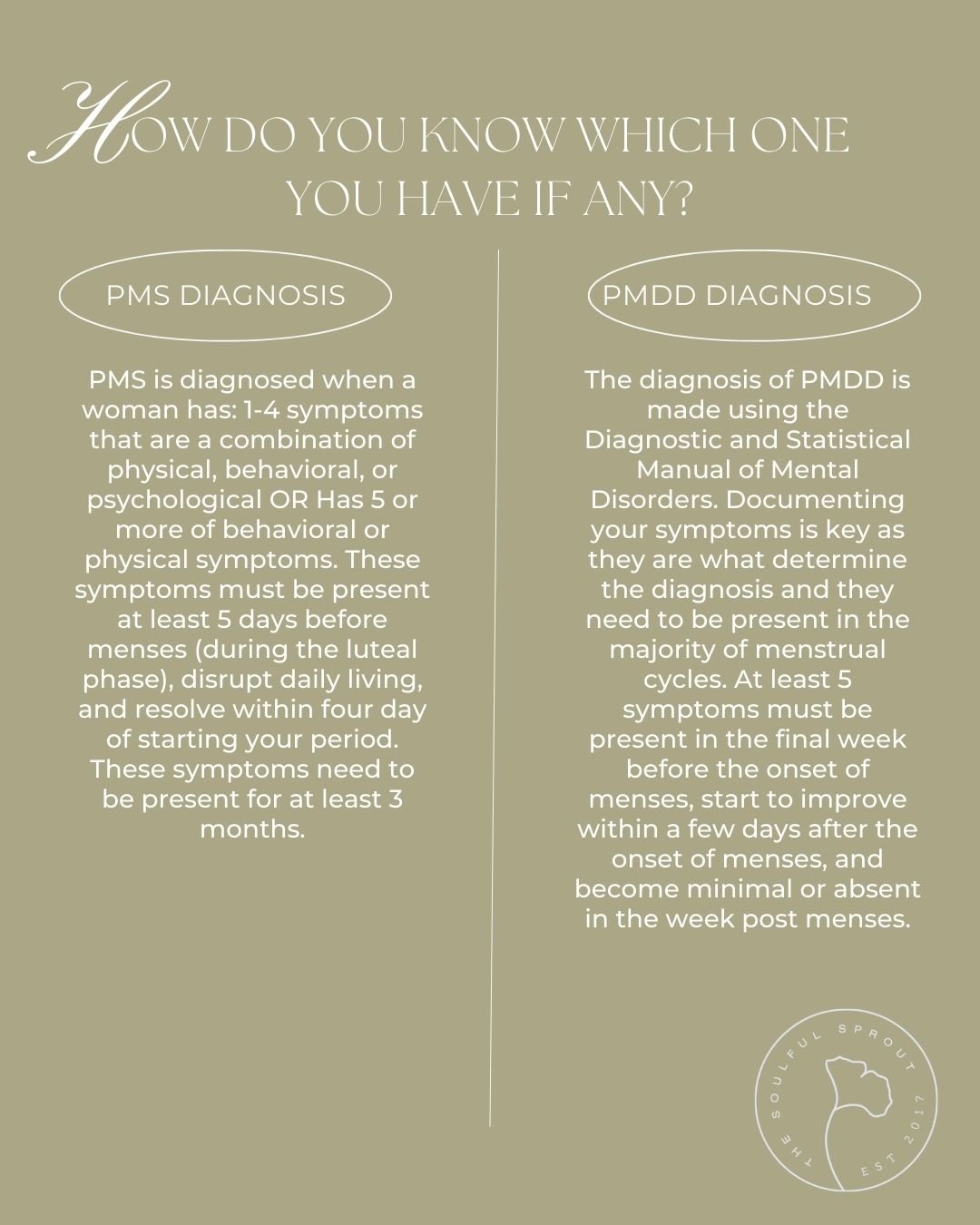Managing PMDD Naturally: A Hormone Nutritionist's Guide
Understanding PMDD and the Natural Approach
Premenstrual Dysphoric Disorder, or PMDD, is an often misunderstood and frequently underdiagnosed condition that affects countless women. It's not just about the usual monthly mood swings, PMS or discomfort that many experience with their cycle; PMDD can be an overwhelming and debilitating experience. It's crucial to address PMDD, and even more so, to explore natural ways to manage its symptoms and drivers, as many experience some worsened months vs others.
What is PMDD?
PMDD is a severe form of Premenstrual Syndrome (PMS) that goes beyond typical premenstrual discomfort.
The symptoms associated with PMDD are not simply a minor nuisance; they can be serious disruptor to a woman’s daily life. This disorder can lead to intense mood swings, depression and extreme irritability, physical pain, and a sense of helplessness during the days leading up to menstruation.
For women effected by PMDD, it's not merely a "bad day" or a minor inconvenience. It's a profound and often isolating struggle, impacting relationships, work, self worth and overall well-being. That's why addressing it and finding ways to support it is crucial.
PMDD occurs when GABA receptors are not able to alter their shape and adapt to the rising progesterone levels, which results in severe symptoms in the week or two before your period starts PMDD affects nearly 1 in 20 women worldwide. It is simple put, a problem with the brain’s response to progesterone, not progesterone itself. ⠀
Why Address PMDD Naturally?
While medications are often prescribed to manage PMDD, many individuals seek a natural approach, and for good reason. It's an approach that resonates with the belief that our bodies have a remarkable ability to heal and maintain balance when provided with the right tools. As a hormone nutritionist, I firmly believe that the body's natural systems can be harnessed to alleviate the symptoms of PMDD.
Addressing PMDD naturally means understanding your body's intricate hormonal dance, nourishing it with the right foods, and adopting lifestyle practices that promote well-being. This approach empowers individuals to take an active role in their health and embrace holistic methods that can lead to not just symptom relief but long-term wellness.
My Role as a Hormone Nutritionist
As a hormone nutritionist, I'm here to guide you on this journey. I've dedicated my career to understanding how hormones and nutrition are intricately linked and how the choices we make every day can impact our hormonal balance.
My goal is to share valuable insights and practical tips that can help you manage PMDD effectively and naturally.
In the sections that follow, we'll explore the hormonal underpinnings of PMDD, dietary and nutritional strategies to support your body, lifestyle changes that can make a profound difference, and even herbal remedies and supplements that may ease your symptoms. Together, we'll embark on a journey toward a life with fewer PMDD-related hurdles, more vitality, and a renewed sense of control over your well-being.
So, let's delve into the world of PMDD and uncover the transformative power of natural approaches. Whether you're someone who's been battling PMDD for years or just looking to learn more, I'm here to provide you with knowledge, encouragement, and support. Together, we can unlock the potential of your body's natural resilience.
Let’s discuss hormonal imbalances:
PMDD is fundamentally linked to hormonal imbalances, primarily involving estrogen and progesterone. These two hormones are central players in the female reproductive system and have a profound influence on the menstrual cycle. In individuals with PMDD, these hormonal fluctuations are more pronounced and can contribute to the severe symptoms experienced.
Estrogen, the hormone responsible for stimulating the growth of the uterine lining, can sometimes become imbalanced in PMDD. Elevated levels of estrogen, in conjunction with low levels of progesterone, can lead to an overstimulation of the uterine lining, causing some of the physical symptoms and emotional turbulence associated with PMDD.
The hormonal imbalances in PMDD can have a cascading effect on both the body and the mind. Excessive estrogen, in particular, can exacerbate mood swings and emotional sensitivity. It can lead to increased emotional reactivity and heightened stress responses. Meanwhile, low progesterone levels can amplify physical discomfort and may contribute to bloating and breast tenderness.
These hormonal fluctuations are like a storm within the body, creating a turbulent environment that manifests as the challenging symptoms of PMDD. It's vital to remember that these imbalances can vary from person to person, which is why personalized strategies are often necessary for effective management.
By understanding the intricate connection between hormones and PMDD, we can better appreciate the role that nutrition and lifestyle changes play in restoring hormonal balance and alleviating these symptoms naturally. This is a key aspect of what we'll delve into in the subsequent sections of this blog post.
Diet and Nutrition for PMDD
To alleviate PMDD symptoms naturally, consider making some important dietary changes.
Start by reducing or eliminating certain trigger foods that can exacerbate PMDD symptoms.
Sugar, caffeine intake (especially after ovulation), and highly processed foods are known to disrupt hormonal balance and contribute to mood swings and physical discomfort.
Cutting back on these substances can help you regain control over your symptoms.
Adopting a balanced diet is at the core of PMDD symptom management.
A diet rich in fruits, vegetables, whole grains, and lean proteins provides your body with essential nutrients needed to support hormonal balance and overall well-being. These foods supply a wide range of vitamins, minerals, and antioxidants that promote hormonal health and can help reduce the severity of PMDD symptoms.
Certain foods and nutrients have been shown to support hormone balance and alleviate PMDD symptoms. Here are some recommendations:
Omega-3 Fatty Acids: These healthy fats, found in fatty fish like salmon, mackerel, trout, sardines, hemp seeds and flaxseeds, can help reduce inflammation and ease mood swings associated with PMDD.
Magnesium: Magnesium-rich foods like dark leafy greens, nuts, and whole grains can help regulate hormones and reduce bloating and breast tenderness.
Vitamin B6: Foods like bananas, sweet potatoes, avocados, beef liver and poultry are rich in vitamin B6, which can help improve mood and reduce symptoms of PMDD.
By incorporating these dietary changes, you can support your body's natural hormone balance and potentially lessen the severity of PMDD symptoms.
Lifestyle Changes
Lifestyle plays a significant role in managing PMDD naturally. Stress management techniques are invaluable. Practices like yoga, meditation, and deep breathing exercises can help reduce stress, improve emotional stability, and ease the emotional rollercoaster often associated with PMDD.
Regular physical activity is not only beneficial for overall health but can also have a positive impact on hormone regulation. Exercise helps balance hormones, reduce stress, and improve mood. Aim for a mix of aerobic and strength-training exercises, and find activities that you enjoy to make it a sustainable part of your routine.
Quality sleep is a powerful ally in mitigating PMDD symptoms. Sleep deprivation can exacerbate mood swings and make you more sensitive to pain and discomfort. Ensure you get enough sleep by practicing good sleep hygiene. This includes maintaining a consistent sleep schedule, creating a relaxing bedtime routine, and keeping your sleep environment comfortable and conducive to rest.
By incorporating these lifestyle changes, you can support your body's natural ability to balance hormones and manage PMDD more effectively. Remember that consistency is key, and it may take time to see the full benefits of these adjustments. Patience and perseverance are essential as you embark on this journey towards a healthier and happier life, free from the burdens of PMDD.
Herbal Remedies and Supplements
In addition to dietary and lifestyle changes, herbal remedies and supplements can be valuable additions to your PMDD management strategy. Here are a few to consider:
Chasteberry (Vitex): Chasteberry is a well-known herbal remedy for PMDD. It's believed to influence hormonal balance by affecting the pituitary gland, which regulates the production of various hormones. Chasteberry may help alleviate symptoms such as mood swings and breast tenderness.
Evening Primrose Oil: This supplement contains gamma-linolenic acid (GLA), which is thought to have anti-inflammatory and hormonal balancing properties. It's often used to reduce breast pain and mood-related symptoms in PMDD.
Calcium: Adequate calcium intake may help reduce some PMDD symptoms, particularly bloating and breast tenderness. Ensure you're getting enough calcium from your diet or consider a calcium supplement.
It's essential to emphasize that before adding any new supplements to your routine, it's critical to consult with a healthcare professional or hormone nutritionist. Everyone's body is unique, and what works for one person may not work for another. A professional can assess your specific needs and help you choose the right supplements in the correct dosage to ensure safety and effectiveness.
Tracking and Monitoring
Tracking and monitoring your PMDD symptoms is a valuable tool in managing the condition. Keeping a symptom journal allows you to identify patterns and potential triggers. It's as simple as noting your symptoms, their severity, and the dates they occur. Over time, you may notice connections between your symptoms and certain times in your menstrual cycle or other factors in your life.
While pen-and-paper journaling can be effective, there are also digital tools and apps designed to make tracking your menstrual cycle and PMDD symptoms more convenient. These apps often provide features such as predicting your next cycle, symptom logging, and even reminders for self-care practices. They can help you gain a more comprehensive understanding of your PMDD patterns and empower you to take proactive steps in managing it effectively.
Seek Professional Help
While natural approaches can be highly effective for managing PMDD, it's vital to recognize that each individual's experience with PMDD is unique. Therefore, seeking professional guidance is crucial. A healthcare provider or a hormone nutritionist can offer personalized advice, tailor treatment strategies to your specific needs, and ensure that you are on the right path to effective symptom management.
For individuals with severe PMDD symptoms, it's important to note that medical intervention may be necessary. In some cases, PMDD can significantly impact one's daily life and emotional well-being. Medications or therapies prescribed by a healthcare provider, such as selective serotonin reuptake inhibitors (SSRIs) or hormone therapy, may be required to alleviate symptoms and improve overall quality of life.
Remember, there is no one-size-fits-all approach to managing PMDD. What works best for you may vary, and it's crucial to take a holistic view that incorporates natural approaches, self-tracking, and professional guidance to find the most effective strategy for your unique experience with PMDD.
IN NEED OF EXTRA SUPPORT?
Check out our FREE cycle syncing guide for tried and true ways to help your body through each phase of your cycle
For extra support around nutrition for your cycle, check our our cycle syncing meal guide with delicious recipes to help keep your cycle on track all month long.
Deep dive in our go at your own pace course: Mend Your Menstrual Cycle for support at managing your period and bringing harmony back in to your body.





